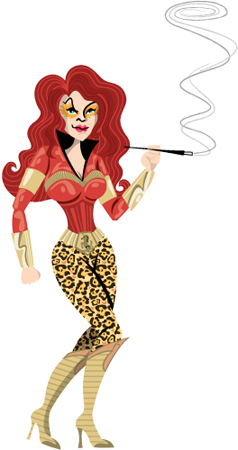I would like, please, for someone to explain to me what grail lore has got to do with Tibet.
Saw Parsifal at the Lyric Opera last night. The music was, as always, gorgeous. The performances were, by and large, very impressive. But when it comes to Wagner, scene design is a major component of the production’s success, not least because of the frequent and lengthy musical interludes – the visual manifestation of the production can keep the story moving, keep it all together. Which brings me back to my question.
Set designer Raimond Bauer, presumably with the permission of Stage Director Nikolaus Lehnoff, and in conjunction with Andrea Schmidt-Futterer (Costumes) and Duane Schuler (Lighting), has set this production in Tibet. Now, I could be wrong about this, but I’m inclined to think that a mythology so deeply rooted in the Christian faith as the story of the Grail and Sacred Spear might not translate so well into an Oriental setting. But even that might be OK in the end. The real problem was trying to reconcile what was going on onstage, visually, with itself.
Act 1 came across as an odd but interesting cross between Star Wars and Dune. With maybe a bit of Indiana Jones thrown in. That was the first part. When a huge rock dislodged from the back wall of the set and rotated away to reveal what seemed to be a birdseye perspective of chairs in a stark gray room, I was impressed with the effect. Confused, but impressed. When the back wall flat flew out to reveal what can only be described as a giant skateboard ramp with chairs affixed to it at right angles, all the way up the vertical incline, I tried to understand. Instead, I got a headache. Again, it might just be me, but what do steel chairs on walls have to do with Tibetan monestaries? I could even cope with the very Dune/Indy sliding stone panel revealing the grail, but chairs on walls? I’m lost. The costumes, in contrast, provide a nice and comprehensible touch to the act, with Parsifal (Gösta Winbergh) and Kundry (Catherine Malfitano) in deep, earthy reds/golds/oranges and the knights in stony gray to match the scenery. We won’t talk about the dreadlocks.
Act 2, the Garden. After a spectacular prologue involving a painted scrim and a flying throne that I could swear is borrowed from the concurrent production of Die Zauberflöte, the (rather disappointing) Garden consisted of the giant skateboard ramp from Act 1, with stuffed mannequins to represent dead bodies and some other random rubble. Again, the costumes were a saving grace, bringing the only remotely botanical touch to the scene. The dresses of the flower/spirits were graceful and evocative, and worked quite nicely with Denni Sayers’ choreography. Kundry’s bud/caterpillar transformation was also quite interesting, although I couldn’t help but feel bad for her walking around on a 30° rake in those platform shoes. Poor Klingsor (Egils Silins), though, was stuck in a huge Kabuki-style getup – while the most colorful thing on stage by a long shot, he couldn’t have helped but feel slightly out of place in his own garden kingdom. Parsifal still had the Act 1 costume, and the dreadlocks, which we still won’t discuss.
Finally, Act 3. What can I say about this? The set was totally incomprehensible. Suddenly, from timeless (if grim) tibetan-fairy-tale-land, we are transported to the early 20th century Orient. The knights reappeared wearing what looked to me suspiciously like WW1 surplus gear, and Parsifal makes his grand reentrance on train tracks. Yes, train tracks. I’ll refrain from commenting on the mass grave/bathtub sunken into the stage left floor, but I can’t resist another dig at the steel furniture. We’re outdoors, apparently, on this set. There are rocks. There are train tracks, for crying out loud. So why is there a steel stool for Gurnemanz (Matti Salminen) to sit on? Did he crush his sitting rock in an earlier performance, or what? Anyway. Back to Parsifal. Reentering on the aforementioned iron road, carrying the giant Sacred Spear, he is wearing what appears to be an ancient Japanese (or fairy-tale, perhaps) mask with his otherwise traditional armor. Traditional in shape, that is. Dreadlocks have transformed to waist-length straight locks. He wears the headband and the traditional smock (under his armor) of a Ronin. I throw up my hands.
So did I hate the opera? Believe it or not, I did not. As previously mentioned, the performance, music and choreography were excellent. And at times, the scene design did work. I enjoyed all of these things immensely, and my seat offered me the leg room to do so without pain. But the design was internally inconsistent, and based on an iffy set of choices from the start. I do understand the need for a scene designer to distinguish himself from those who have gone before, but even with Wagner (perhaps especially with Wagner) it is possible to stray too far. Wagner loved spectacle, and even provides long musical interludes for it, but Wagner also loved the stories and legends that form the basis of our – western – culture. To displace such a story into a locale that has no relationship to it is, it seems to me, to do it a great disservice.

Does this mean you won’t be interested in underwriting my upcoming production of ‘The Barber of Seville’ staged entirely underwater? With an all female, dreadlocked cast? Did I mention how they’ll all be wearing strap-ons, too? And that it will be performed in Klingon? Is that a no?